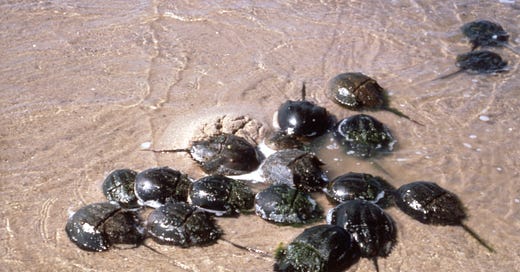Notes from an Environmentalist. Photo: Horseshoe crabs mating on Pleasant Bay July 9. Excerpt from testimony I will be giving to the MA DMF this week. Note I couldn't record the last post.
Protect Horseshoe Crabs;
The Life You Save May be Your Own
When I write about horseshoe crabs I always remind myself that humanity owes a huge debt of gratitude to these fascinating creatures.
Close to a billion human lives were protected by these ancient animals, during the Covid years alone. It was the most successful medical achievement of our lives and it was only possible because of LAL derived from horseshoe crabs.
As the former president of the Associates of Cape Cod, Tom Novitsky has said, “the demand for horseshoe crabs is infinite and growing, but the supply is limited,” so it falls on entities like state of Massachusetts to protect these threatened animals.
So what can Massachusetts do? The first thing is to improve its research. The state has 48 years of by-catch data gathered incidentally when the DMF was trawling for ground fish.
So when they say the population of horseshoe crabs is increasing because their data shows that they caught 8 crabs one year and 12 the next, I’m skeptical.
They also don’t have information about when and at what tide the crabs were caught. Such information is crucial, since the crabs stay buried in the sediment for several hours both day and night during low tides.
By the same token when ecologists rely on data collected on Delaware Bay instead of collected in our own backyard, we can end up thinking that our crabs spawn primarily is May and June.
In fact Massachusetts crabs are still spawning in high, often peak numbers, in both June and July. What ecologists need is a non-invasive way to measure the spawning success during each month of the spawning season.
The second thing I remind myself, is that natural LAL is not an obsolete industry but an industry in transition.
It is still protecting millions of human lives and many of the people who make and use LAL every day say it is still less expensive, more sensitive and easier to use than recombinant C Factor and will remain so for the immediate future. It is still one of the most sensitive assays available in modern medicine.
So LAL users are in the position of my local mechanic. He is enthusiastic about Electric vehicles and knows they are coming, but for now he realizes there is an urgent need for him to continue to repair internal combustion engines with the equipment and expertise his mechanics already have.
So until an artificial form of LAL is perfected and accepted by federal regulators it remains incumbent on states like Massachusetts to control the harvesting of crabs to protect both the crabs, the environment and humans.




